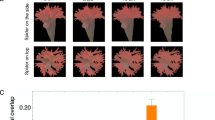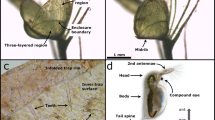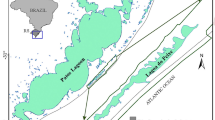Abstract
To determine whether perching dragonflies visually assess the distance to potential prey items, we presented artificial prey, glass beads suspended from fine wires, to perching dragonflies in the field. We videotaped the responses of freely foraging dragonflies (Libellula luctuosa and Sympetrum vicinum—Odonata, suborder Anisoptera) to beads ranging from 0.5 mm to 8 mm in diameter, recording whether or not the dragonflies took off after the beads, and if so, at what distance. Our results indicated that dragonflies were highly selective for bead size. Furthermore, the smaller Sympetrum preferred beads of smaller size and the larger Libellula preferred larger beads. Each species rejected beads as large or larger than their heads, even when the beads subtended the same visual angles as the smaller, attractive beads. Since bead size cannot be determined without reference to distance, we conclude that dragonflies are able to estimate the distance to potential prey items. The range over which they estimate distance is about 1 m for the larger Libellula and 70 cm for the smaller Sympetrum. The mechanism of distance estimation is unknown, but it probably includes both stereopsis and the motion parallax produced by head movements.




Similar content being viewed by others
References
Baird JM, May ML (1997) Foraging behavior of Pachydiplax longipennis (Odonata: Libellulidae). J Insect Behav 10:655–678
Baldus K (1926) Experimentelle Untersuchungen über die Entfernungslokalisation der Libellen (Aeschna cyanea). Z Vergl Physiol 3:475–505
Bauer T (1981) Prey capture and structure of the visual space of an insect that hunts by light on the litter layer (Notiophilus biguttatus F., Carabidae, Coleoptera). Behav Ecol Sociobiol 8:91–97
Burkhardt D, Darnhofer-Demar B, Fischer K (1973) Zum binokularen Entfernungssehen der Insekten. I. Die Struktur des Sehraums von Synsekten. J Comp Physiol A 87:165–188
Collett TS (1978) Peering—a locust behaviour pattern for obtaining motion parallax information. J Exp Biol 76:237–241
Collett TS, Land MF (1978) How hoverflies compute interception courses. J Comp Physiol 125:191–204
Eriksson S (1980) Movement parallax and distance perception in the grasshopper (Phaulacridium vittatum). J Exp Biol 86:337–340
Frye MA, Olberg RM (1995) Receptive field properties of feature detecting neurons in the dragonfly. J Comp Physiol A 177:569–576
Higashi K (1973) Estimation of food consumption for some species of dragonflies. I. Estimating by observation of the frequency of feeding flight of dragonflies. Rep Ebino Biol Lab Kyushu Univ 1:109–116
Horridge GA (1978) The separation of visual axes in apposition compound eyes. Phil Trans Roy Soc B 285:1–59
Hoppenheit M (1964) Beobachtungen zum Beutefangverhalten der Larve von Aeschna cyanea Müll. (Odonata) Zool Anz 172:216–232
Kirmse W, Lässig P (1971) Strukturanalogie zwischen dem System der horizontalen Blickbewegungen der Augen beim Menschen und dem System der Blickbewegungen des Kopfes bei Insekten mit Fixationsreaktionen. Biol Zbl 90:175–193
Labhart T, Nilsson D-E (1995) The dorsal eye of the dragonfly Sympetrum: specializations for prey detection against the blue sky. J Comp Physiol A 176:437–453
Land MF, Nilsson D-E (2002) Animal eyes. Oxford University Press, Oxford
Miller PL (1995) Visually controlled head movements in perched Anisopteran dragonflies. Odonatologica 24:301–310
Olberg RM (1986) Identified target-selective visual interneurons descending from the dragonfly brain. J Comp Physiol A 159:827–840
Olberg RM, Worthington AH, Venator KR (2000). Prey pursuit and interception in dragonflies. J Comp Physiol A 186:155–162
Rossel S (1983) Binocular stereopsis in an insect. Nature 302:821–822
Rossel S (1986) Binocular spatial localization in the preying mantis. J Exp Biol 120:265–281
Schwind R (l989) Size and distance perception in compound eyes. In: Hardie R, Stavenga D (eds) Facets of vision: compound eyes from exner to autrum and beyond. Springer Verlag, Berlin, Heidelberg, New York pp 425–444
Srinivasan MV, Lehrer M, Zhang SW, Horridge GA (1989) How honeybees measure their distance from objects of unknown size. J Comp Physiol A 165:605–613
Sherk TE (1978) Development of the compound eyes of dragonflies (Odonata) III. Adult compound eyes. J Exp Zool 203:61–80
Sobel EC (1990) The locust’s use of motion parallax to measure distance. J Comp Physiol A 167:579–588
Walcher F, Kral K (1994) Visual deprivation and distance estimation in the praying mantis larva. Physiol Entomol 19:230–240
Wallace GK (1959) Visual scanning in the desert locust Schistocerca gregaria Forskal. J Exp Biol 36:512–525
Acknowledgements
We thank Sandee Goci for her assistance in the fieldwork and Dr Manuel Leal for use of his computer and Videopoint software. This study was supported in part by NSF RUI 0211467 grant to RMO, and by a Union College summer research fellowship to CEB. All experiments complied with the “Principles of animal care”, publication No. 86–23, revised 1985, of the National Institute of Health.
Author information
Authors and Affiliations
Corresponding author
Rights and permissions
About this article
Cite this article
Olberg, R.M., Worthington, A.H., Fox, J.L. et al. Prey size selection and distance estimation in foraging adult dragonflies. J Comp Physiol A 191, 791–797 (2005). https://doi.org/10.1007/s00359-005-0002-8
Received:
Revised:
Accepted:
Published:
Issue Date:
DOI: https://doi.org/10.1007/s00359-005-0002-8




